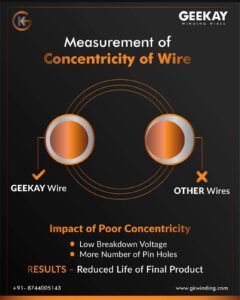Electric Motor is the heart of most electrical products and appliances. A faulty or sub-optimal motor breaks or reduces the lifespan of the equipment. This results in higher warranty failures, product recalls and moreover losing credibility in the market.
Though the reasons for a motor failure can be many, a lot of it can be attributed to the use of poor quality winding wires, as winding wire (or magnet wires) is a crucial component of an electric motor.
To provide reliable products for your consumers and maintain trust, it is ideal to go for winding wires which go through strict quality checking via state of art testing methods. Among the various winding wire testing methods, testing for the concentricity of wire is very important. This can guarantee the quality of winding wires for your product application.
What is concentricity of a winding wire?
Concentricity of motor winding wire (or magnet wire) refers to the alignment of the wire within the winding. In other words, it is the degree to which the wire is centered within the winding.
Correct concentricity ensures that the conductor diameter and enamel coating thickness are uniform throughout the winding wire. It enables the magnet wire to produce a stable magnetic field, thus improving the efficiency of the motor.

Here are some of the common problems in winding wires due to improper Concentricity and their impact on product performance:-
| Problems | Impact |
| Low BDV | Layer NG or winding short |
| Pin Holes | Layer NG or winding short |
| Colour variation | Layer NG or winding short |
Importance of concentricity in wire for the long life of the motor
As said earlier, proper concentricity ensures optimal performance and increases the longevity of the motor. Let us see how –
Breakdown Voltage
The thickness of the insulation or enamel determines the breakdown voltage (BDV) of the magnet wire. Higher the thickness, the higher the breakdown voltage.
If the insulation is not uniform, the weak spot (where the layer of insulation is lower) leads to failure of the winding. This has a long-term impact and may not be evident immediately after making the motor and testing. This makes it even more critical as it leads to field failures.
Having precise concentricity ensures good breakdown voltage of the wire.
Reduce Pinholes
Pinholes are the discontinuities or breaks in the insulation or enamel covering. The presence of pinholes in enamelled winding wires can cause current leakages.
Often, during the winding installations in motors, wires are stretched causing pinholes to stretch as well. And it can occur for a pinhole to come on top of another, resulting in short-circuit.
Thus, a defective coating leads to lesser insulation, thus increasing operating voltage leading to wire failure (and electrical equipment failure). By ensuring proper concentricity, you can reduce the number of pinholes in a winding wire.
Color Variation
This is only an indicator and happens because the insulation on one side is more than that on the other side. The result is a little overcuring of the wire on one side in comparison to the other side, resulting in pin holes and poor consistency in breakdown voltage.
A concentricity test reveals such enamel anomalies in the winding wires. And a quality-focused winding wire manufacturer incorporates various testing methods to ensure precise concentricity of the wires.
Concentricity Testing at Geekay
Here is a video on concentricity testing of winding wires at Geekay.
Concentricity testing usually involves a combination of optical measurements as well as inductive measurements. By correlating both and making a scatter plot of the oscillating eccentricity values, the concentricity of the wire is tested.
At GK Winding we follow strict quality controls and testing methods to ensure precise concentricity of the magnet wires we deliver for your products. We use single line single oven concept for increased thermal equilibrium in the oven. Thereby, we can guarantee that the quality and consistency of the wire remain the same throughout the spool.
Check out our winding wire offerings and solutions.


